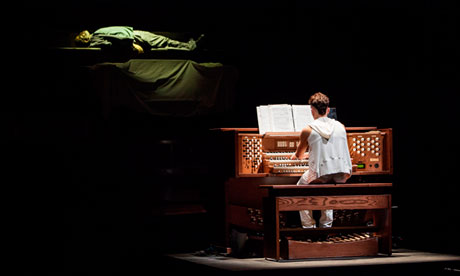
One of Michelangelo's last drawings was of an old man. Beneath it he scribbled the words "I'm still learning". Shostakovich, forced to work only with his left hand in his final years yet refusing to yield to illness or despair, took the same view. He was near death when in 1974 he set sonnets by the Italian Renaissance master. Their preoccupation with mortality is raw. "Though the body still yearns for sensual pleasures, the soul wishes for death," runs one merciless couplet.
In a spirited coup, Manchester international festival opened last Thursday with a staging of these Michelangelo Sonnets – settings of 11 poems in Russian – directed by the American maverick Peter Sellars and arranged dazzlingly for organ by Cameron Carpenter, who performed them with the bass-baritone Eric Owens, a powerful Alberich in the New York Met's recent Ring Cycle.
The venue was the vast Albert Hall, built in 1910 as a Methodist central hall in the city's entertainment district in vain hope of fostering temperance and saving souls and livers. (Think "Follow the fold and stray no more" Mancunian/Wesleyan-style.) The grand horseshoe space, with ornate columns, plasterwork and coloured glass, has been closed to the public since 1969.
It proved an inspired choice of venue. The building's missionary past added a ghostly dimension to the shadowy spirituality of Shostakovich's work. Michelangelo's poems themselves, no mere versifying but central to the canon of Italian literature, embrace truth, love, anger, creativity, immortality. As ever favouring the demotic, Sellars had Owens as a lumbering janitor.
Here was Everyman, alone with mop, plastic bucket and rubbish bin, sweeping up the detritus of life. Let's not labour the metaphor. Owens adopted various poses, sometimes against projected images of dereliction or physical distress, as a man passing through the stages of sleep: now bent, now stretched, now embryonic.
No staging is required for these songs, but with these artists, in this space, it worked. The impact was quiet and effective, with Owens at once lurching towards and recoiling from the demands of music and text. Carpenter – the elfin organist with peaked quiff, half-shaven head, tight white trousers and hoody, conspicuous biceps and puppy heels – charmed infinite variety from a digital organ. The wan, jaunty coda sounded like a spectral hurdy gurdy.
The Shostakovich was paired with Bach's cantata BWV 56, Ich Will Den Kreuzstab Gerne Tragen ("I will carry the cross gladly"). This is a work of extreme anguish and eventual solace, in which the earthly life is compared to a tempestuous sea voyage, with rippling left-hand arpeggios to evoke the billows. Owens, still with his mop/staff and a white draw sheet, sang movingly once he settled into the performance. Cameron's solo playing replaced the sung closing choral, the words shown silently on a screen. I'd like to have heard it all again.
Hippolyte et Aricie (1733) at Glyndebourne, though never dull, did not provoke that same urge. The hunter-goddess Diana, frigid and stately, resides in the freezer along with a range of chilly charcuterie. Flame-feathered Cupid cracks his way out of an egg on the top shelf, ready for trouble. A chorus in white furs, who share the fridge, soon abandon their coats to perform what might be called the "dance of the underpants".
It was an eye-catching if tacky start to Glyndebourne's first venture into Rameau by the team who created Purcell's The Fairy Queen for the festival: the director Jonathan Kent, the designer Paul Brown and the conductor William Christie. Of the many conventions in French baroque opera, the interruption of the action by dance and chorus is the most defining. In the course of a long evening we were diverted by a clump of dancing, cobwebby bugs behind the refrigerator and a "hello sailor" interlude of knock-kneed sea scouts, among others. Despite the Busby Berkeley photo in the programme, drill was none too strict.
Based on Racine's Phèdre, Rameau's tragédie lyrique tells of Phaedra's obsession with her stepson, here a gauche teenager with bedroom to match. Sarah Connolly, ever bewitching in this repertoire, made the role seem more dominant than it is, if you count minutes on stage. Her Phaedra was poised, lustful and tragic to her sorrowful end, before a conventional happy finale punctures the effect.
After a wobbly prologue, the singing was mostly good or better. Stéphane Degout's beautifully focused Theseus stood out. The youthful trio of mezzo Katherine Watson (Diana), soprano Christiane Karg (Aricie) and tenor Ed Lyon (Hippolytus) sang idiomatically, giving clarity to recitatives and arias and enlivening the longueurs.
The chief disappointment was in musical ensemble. Co-ordination between pit and stage often went awry. The Orchestra of the Age of Enlightenment, as consistent and virtuosic as any around, were caught between keeping up with the singers or waiting for Christie's emphatic yet tardy beat. Nevertheless many glorious instrumental solos and lovely, pointed continuo playing carried the evening, even if the whole left one hungry.
It all looked stunning. You might complain that Paul Brown's design straddled too many visual styles, yet it retained a bizarre unity thanks to Mark Henderson's lighting. His invention of silvers, greys, blues, at once cold and shimmering, made everything from dead stags, suspended and frozen, to an abattoir and a mortuary appear objects of beauty. Pack a tofu burger and watch it live in cinemas on Thursday 25 July.

